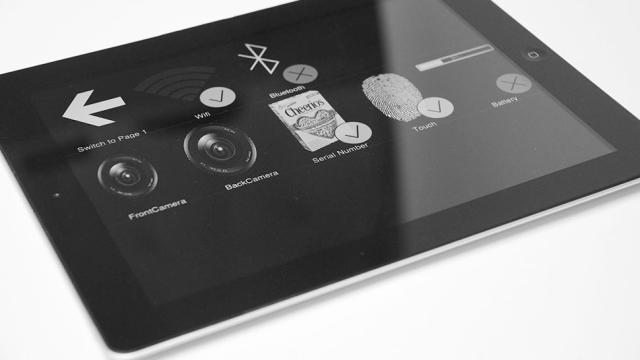While Jony Ive’s group was secretly working on the iPad, Steve Jobs was telling the public and press that Apple had no intention of releasing a tablet. “Tablets appeal to rich guys with plenty of other PCs and de- vices already,” he said publicly. But Jobs was dissembling. “Steve never lost his desire to do a tablet,” said Phil Schiller. In fact, while Jony’s design team was developing the iPhone, they were also actively working on tablets. Jobs was just waiting for the right time to bring a tablet to market.
This post has been excerpted from Jony Ive: The Genius Behind Apple’s Greatest Products, by Leander Kahney, available November 14 from Portfolio/Penguin Press.
One incentive to move forward was the appearance of netbooks, a category of small, inexpensive, low-powered laptops that launched in 2007. They quickly started to eat into laptop sales and, by 2009, netbooks accounted for 20 per cent of the laptop market. But Apple never seriously considered making one. “Netbooks aren’t better than anything,” Steve Jobs said at the time. “They’re just cheap laptops.”2 Nonetheless, the subject came up several times in executive meetings.
During one such high-level executive meeting in 2008, Jony proposed that the tablets in his lab could be Apple’s answer to the netbook. Jony suggested that a tablet was basically an inexpensive laptop without the keyboard. The idea appealed to Jobs, and Jony was given the go-ahead to transform the prototypes into a real product.
Crucially, mobile technology had advanced significantly in just a few years since the iPhone had been launched. By then, the 035 tablet prototype from 2004 seemed big and unwieldy. But thanks to new screens and batteries, everyone understood that a tablet could be much lighter and slimmer. One of the major reasons the iPad hadn’t been green-lighted sooner was that the components like the screen and battery weren’t ready. “The technology was not there yet,” said a former Apple executive.
Jony began by ordering 20 models made in varying sizes and screen-aspect ratios. They were laid out on one of the studio’s project tables for Jony and Jobs to play with. “That’s how we nailed what the screen size was,” Jony has said.3 They had done the same thing earlier in finding the right size for the Mac mini and other products.
“Steve and Jony liked to do that with almost all products,” said a former engineer in the operations group. “They started off making a bunch of ‘appearance’ models and they’d make them in all sorts of sizes to find what they want.”
But, as often happens, recollections seem to vary. According to an executive at Apple at the time, the screen size was also strongly influenced by a simpler piece of equipment: a standard piece of paper. “The size of the tablet was that of a sheet of paper,” he explained. “It was conceived as a legal note tablet, and we thought that was the right size. It was targeted at education and schools and e-reading.” Hardware was still another factor, as the guts of the iPad would be based not on the iBook but the iPod touch. Early on, the iPad was understood to be, in effect, a scaled up touch-screen iPod.
Jony’s ultimate goal was to make a device that needed no explanation and was fully intuitive. It was to be a “breathtakingly simple, beautiful device, something that you really want, and something that’s very easily understandable,” Stringer said. “You pick it up, you use it, something that . . . needs no explanation.”
That said, producing the “breathtakingly simple” can require an immense investment of time and creative energy.

Making the Machine
Jony’s design team explored two different design directions for the iPad, directly akin to the twin design directions they pursued with the iPhone.
Based on the Extrudo design, the first approach built upon a case that resembled the extruded aluminium iPod mini. It was just bigger and flatter. The design lead on this version was Chris Stringer, who also worked on the Extrudo iPhone. As with the phone designs, Stringer’s Extrudo iPad was made of a single piece of extruded, milled aluminium. It, too, had plastic caps for the Wi-Fi and cell phone radios. In this case, though, sharp edges weren’t much of a concern; no one was going to press a tablet up to his or her face.
Jony’s ID team experimented with some “picture frame” models, larger than some of the iPad prototypes, which had kickstands to prop them up. (Kickstands would also feature prominently in competing tablets from Microsoft and other manufacturers in the future.) Jony’s team didn’t pursue the idea, although adding a kickstand would appear later in the iPad 2’s magnetic cover, which could be folded back into a stand.
The designers found Stringer’s Extrudo iPad suffered the same limitation as the Extrudo iPhone: The bezel detracted from the screen. As Jony put it, “How do we get out of the way so there aren’t a ton of features and buttons that distract from the display?” Again, Jony wanted the infinity-pool illusion because he understood the screen was all-important and that nothing should detract from it.
Meanwhile, Richard Howarth brought his experience with the Sandwich iPhone models to his prototypes, making several versions of Sandwich-style iPads. The early Sandwich iPad models resembled more svelte versions of the 035 prototype. Made of shiny white plastic with a boxy shape, they are clearly in the same design family as Apple’s plastic MacBooks, released early in 2006 — which makes sense given that they were designed largely by Howarth. Like the plastic MacBook, the device at that point remained fairly big and chunky. Still, Jony’s team was clearly homing in on how to present the screen, and the bezel was plain and unobtrusive.
As the design progressed, the new models got thinner, the edges sharper. Some had aluminium backs, but Jony’s team seemed to be veering in the direction of the Sandwich. Yet something bothered Jobs: Somehow the iPad wasn’t quite casual enough.
Jony spotted the problem. The iPad needed a cue, some sign that it was friendly and could be picked up easily with just one hand. As usual, Jony wanted to invite users to touch the device, pick it up and hold it and have a tactile experience.
The logical next step seemed to be adding handles, and Jony’s team experimented with them in an attempt to ease picking up the iPad. One of the later prototypes featured a pair of large plastic handles, making it look like a particularly inelegant TV dinner tray. When they realised the handle approach clearly wasn’t working, Jony’s team started exploring a tapered back that swept away underneath the screen, opening a gap for fingers to slide underneath.
As Jony’s team homed in on the iPad design, they were also completing work on the second-generation iPhone. Marketed as the iPhone 3G, to highlight its compatibility with new 3G cell phone networks, the 2008 follow-up dispensed with the original’s aluminium back plate in favour of a hard, polycarbonate plastic. Not surprisingly, then, the two simultaneous development projects shared numerous elements, as the iPad would also get a polycarbonate back, coloured black or white, with a stainless steel bezel to marry the back plate to the screen.
Just as they agreed upon a design, however, production problems forced Jony to change it.
The plastic back of the iPhone 3G looks simple, but was extremely hard to manufacture. Jony and the team wanted to use a similar shell for the iPad (comprising a strong blend of polycarbonate and acrylonitrile butadiene styrene), but it proved to be more difficult to manufacture at the larger iPad size, as the larger shell would shrink and warp when it came out of the mould. To stop it from shrinking at the edges, the shell was moulded larger than it needed to be and machined down to size.
Even after moulding, the shell still had to be polished to remove the part lines, then painted and machined again to prevent the paint shrinking around openings. The manufacturing process gained additional steps, with the openings painted over, then machined out before the installation of the buttons, the speaker grilles and the Apple logo on the back. The use of the plastic had made the entire process problematic. “You have to set those machining processes in the right order because if you machine before you paint, the chemistry of the paint relaxes the surface tension of the plastic and then the sink goes into other areas that you already machined,” [designer Doug] Satzger said. “It’s just easier to do it with aluminium than with plastic.”
Jony’s team went back to the drawing board and designed an aluminium back. They were comfortable with the material; they already had the process and the production lines down. The new aluminium back wasn’t as tapered as Jony would have liked. To give the iPad stiffness, the designers had to add a thin sidewall that gave it strength but made it thicker and bulkier than the planned plastic version.
When they were done, however, Jony’s team was excited by the stark minimalism of the device. “We had tried so many things,” remembered Chris Stringer. “But at the end of the day, we realised it needed to be its own self. We can’t copy ourselves. We wanted a unique form . . . a very anonymous object, not playing along with the lines of consumer electronics at all.”
The iPad they produced didn’t feel like anything else. As Stringer put it, “it felt like a new object.”
Top picture: A prototype iPad with two dock connectors on the bottom and side. Used with permission.
